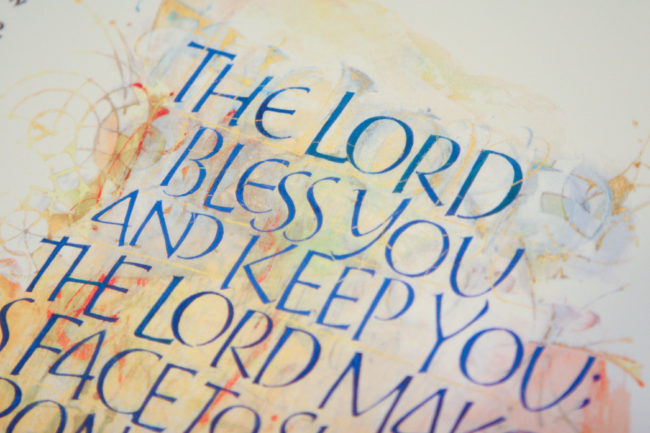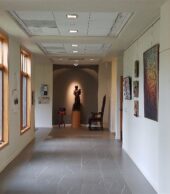This reflection about sustained lectio divina is excerpted from Dr. Kathleen Cahalan's keynote lecture at the Benedictine Center on 27 Oct 2017, "Today This Scripture Is Fulfilled in Your Hearing." Click here for the full transcript, including a demonstration of lectio using the Gospel of Luke.
Dr. Cahalan is professor of practical theology at Saint John’s University School of Theology and Seminary and director of the Collegeville Institute Seminars. She also serves as the core teacher for the Benedictine Center's School of Lectio Divina and School of Discernment.
Practicing Sustained Lectio Divina
My Journey with Lectio
I’ve been practicing some form of lectio divina since sixth grade. As a child I had the desire to read the whole bible. I somehow had the idea that I wanted to read the bible from beginning to end. I started in but found that I knew the first few stories so I thought it might be better to begin in another place. So, I started at Ecclesiastes. I did not get far because the text was so strange and I could not understand it. My attempt faltered and I never made it all the way through either that book or the bible.
Around the same time I realized that there was such a thing as the daily lectionary. As children we planned and attended daily mass once a week with our grade level and it is probably in this context that I was exposed to the “reading of the day.” Somehow, I came to understand that whole books were read over time, with a selection each day, and that if you read along every day you would eventually read a book. I mistakenly thought the whole bible was read during the year; it was years before I learned there was a three-year cycle and that we read only a small portion of the Hebrew Bible and New Testament.
Nevertheless, I decided to follow this method, but to do so I needed access to the daily readings and I needed a bible at home. Because I was often in the church after school practicing for my organ lessons, I decided to “borrow” a missalette, take it home, and copy down the list of readings for each day, which were listed in the back pages. I would return the missalette the next day, so it was not quite stealing. I purchased The Jerusalem Bible at a religious bookstore in our downtown. This is how I began to pray the scriptures each day. I recognized it as a very “catholic” prayer since people all over the world were reading these same texts at the liturgy.
When I was 16 years old, I began reading spiritual writings. I read Henri Nouwen’s book, Genesee Diary, which is the story of his nine-month stay at a Trappist monastery. He learns to pray the liturgy of the hours and discovers the mystery of immersing himself daily in the scriptures. He learns of Thomas Merton’s desire to memorize the psalms and the New Testament; Merton feared that if he were ever in a place without a bible, such as a prison, he needed to know the text. I learned, like Nouwen, that there was a larger world of daily and liturgical prayer with scripture that shaped morning and evening. The first psalm I memorized was Psalm 4, which I began to say at bedtime.
A second influential book on prayer I read as a teenager was You: Prayer for Beginners by Mark Link, S.J. You, a little “how-to” book for beginners, demonstrated how to pray with scripture in a simple format. The method, I now know, was lectio divina, in 4 parts—lectio, meditation, oratio, contemplation—though Link did not use that language. He taught the reader how to read a passage slowly, savoring words or phrases and rereading the passage several times. He combined lectio divina with the Ignatian examen as a daily practice.
If you practice lectio divina, I’m sure you have tried different approaches and methods too. For me lectio is any approach in which we have a dialogue with God through the biblical text over time—reading the daily readings (whether at Mass or not), memorizing a psalm, or adopting the technique of slow reading.
Today I practice a form called sustained lectio, which means that I stay with a text, or the text stays with me, over a period of time.
Sustained lectio divina
The ancient practice of lectio divina has been retrieved and practiced in a variety of ways today. One method is sustained lectio divina. Mary Margaret Funk says the “lectio divina is a sustained immersion into a revelatory text.” I describe it as a dialogue with God through the text over time. She retrieved the approach to scripture taught by the Alexandrian Catechetical School in which both the literal and the spiritual sense of the text was studied and listened to.
What does sustained attention to the same text reveal to us about God, ourselves, and our world? Tonight I’ve demonstrated my practice of sustained lectio divina with Luke 4. I listened to several voices of the text:
The literal voice
We hear the literal voice by studying the text, by receiving it with our logical senses: what does the text say? It is understand the world behind the text (what it meant)
- Who? What? Where? When? Why?
- Ask questions of historical critical studies: when was the text written, who is the author, what type of literature is it, what is it related to, is it quoted elsewhere, what do the names/words mean in their original
- Read commentaries, experts, compare them, keep studying
- Look up words and phrases (e.g. word of God, fulfillment)
In this case, I turned to several commentaries on the gospel of Luke by respected biblical scholars.
But be careful – we can treat bible study as an end in itself. The great medieval scholar, Jean Leclercq, says: “Christian reading of Scripture is not primarily an intellectual exercise resulting from the correct use of a scientific method. It is essentially an experience of Christ, in the Spirit. Within this experience there is, of course, room for method, science and use of instruments of work and study, the knowledge of philology, archeology and history. But these alone will never result in lectio divina, a Christian reading, a reading in the Spirit, a reading of Christ and in Christ, with Christ and for Christ.”[1]
The symbolic voice
What is the meaning of the text? Level of meditation, using artistic senses. In the Alexandrian school it is called allegorical, Christological, typological, symbolic, spiritual, hidden – the words are used to point to something else.
- Hidden meanings: use meditation to ponder on the hidden meaning of the text.
- Origen – there is a presence of meanings to be sought beneath or beyond the verbal surface – these are “forms and figures of hidden, sacred things” and even when one does not understand a hidden meaning, one should sense intuitively that something is indeed hidden there. The Spirit makes known to us the meanings.
- Augustine – “Know these books even if they are not understood."
- Funk – Set aside logical mind but do not replace it.
The truth of the story is in some facts, but some are symbols for something else. In this text, several hidden meanings were here for me that emerged: Jesus’ actions, word, the reactions, Jesus reading to me.
The moral voice
Raymond Studzinski writes, “In the process of connecting with the creative action of God, lectio is a form of proclaiming the Word (especially the Scriptures) or of preaching to the self. Each word is brought to bear on life with its present challenges and opportunities. In this sense readers, in effect, preach to themselves, actualizing the text in terms of their life context.”[2]
The moral voice asks: What does this text mean for me? What is it asking of me? What is my personal response?
I can be amazed at Jesus’ word or respond with fury. The text brings both judgment and good news. We are called to renounce sins, to renounce sin from my afflictions, to renounce my thoughts. The good news is that God wants to heal these afflictions and calls me to proclaim the good news, to set captives free, and bring sight to the blind. As Meg Funk writes: “With the personal response we walk in the privileged garden of intimacy with the Lord…this third dimension becomes a living, conscious, active way of being before God….the personal response in three senses: first we humbly repent, remove obstacles to our relationship; second, we might pray from our hearts and souls; third, we simply do the word, as in charity or personal outreach toward the poor.”[3]
The mystical voice
I wait upon the mystical voice.
Conclusion
My childhood dream came true, of course not in the way I imagined. All prayer is prayer with Jesus to the Holy One. When we pray Jesus is praying with us, we are praying with him. He lifts our prayers up to God.
And lectio is the way in which Jesus reads the Scripture to us. Jesus is the scroll unrolled and the word read. It is the way the Word proclaims the Word personally to each of us.
And as it is read, we realize: Jesus is the Word that reads the text of my life – the Word shows me myself. And the Word reveals to me the Holy One.
I have benefitted from sustained lectio because it allows me to be a pupil who seeks to understand, an artist who can use her imagination, and a seeker of wisdom who live my life more faithfully. In conclusion, lectio divina is following the Word on his way, and pressing in on him to listen to him, the Word among us.[4]
Today this Scripture is fulfilled in your hearing.
 Interested in learning more?
Interested in learning more?
Consider attending an upcoming School of Lectio Divina.
Feb. 23-28, 2018 with Dr. Cahalan
Jul. 20-21, 2018 with Samuel Rahberg
Learn more about core Benedictine values.
[1] Quoted in Studzinski, 191.
[2] Studzinski, 215.
[3] Funk, Lectio Matters, 47
[4] Journal, 9.19.17







0 Responses